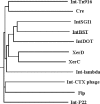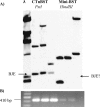Integration site selection by the Bacteroides conjugative transposon CTnBST
- PMID: 17616597
- PMCID: PMC2045163
- DOI: 10.1128/JB.00668-07
Integration site selection by the Bacteroides conjugative transposon CTnBST
Abstract
A newly discovered Bacteroides conjugative transposon (CTn), CTnBST, integrates more site specifically than two other well-studied CTns, the Bacteroides CTn CTnDOT and the enterococcal CTn Tn916. Moreover, the integrase of CTnBST, IntBST, had the C-terminal 6-amino-acid signature that is associated with the catalytic regions of members of the tyrosine recombinase family, most of which integrate site specifically. Also, in most of these integrases, all of the conserved amino acids are required for integration. In the case of IntBST, however, we found that changing three of the six conserved amino acids in the signature, one of which was the presumed catalytic tyrosine, resulted in a 1,000-fold decrease in integration frequency. Changes in the other amino acids had little or no effect. Thus, although the CTnBST integrase still seems to be a member of the tyrosine recombinase family, it clearly differs to some extent from other members of the family in its catalytic site. We also determined the sequence requirements for CTnBST integration in the 18-bp region where the crossover occurs preferentially during integration. We found that CTnBST integrates in this preferred site about one-half of the time but can also use other sites. A consensus sequence was tentatively derived by comparison of a few secondary sites: AATCTGNNAAAT. We report here that within the consensus region, no single base change affected the frequency of integration. However, 3 bp at one end of the consensus sequence (CTG) proved to be essential for integration into the preferred site. This sequence appeared to be at one end of a 7-bp crossover region, CTGNNAA. The other bases could vary without affecting either integration frequency or specificity. Thus, in contrast to well-studied site-specific recombinases which require homology throughout the crossover region, integration of CTnBST requires homology at one end of the crossover region but not at the other end.
Figures







References
-
- Caparon, M. G., and J. R. Scott. 1989. Excision and insertion of the conjugal transposon Tn916 involves a novel recombination mechanism. Cell 59:1027-1034. - PubMed
-
- Cheng, Q., Y. Sutanto, N. B. Shoemaker, J. F. Gardner, and A. A. Salyers. 2001. Identification of genes required for the excision of CTnDOT, a Bacteroides conjugative transposon. Mol. Microbiol. 41:625-632. - PubMed
-
- Holdeman, L. V., and W. E. C. Moore. 1975. Anaerobe laboratory manual, 4th ed. Virginia Polytechnic Institute and State University, Blacksburg.
Publication types
MeSH terms
Substances
Grants and funding
LinkOut - more resources
Full Text Sources

